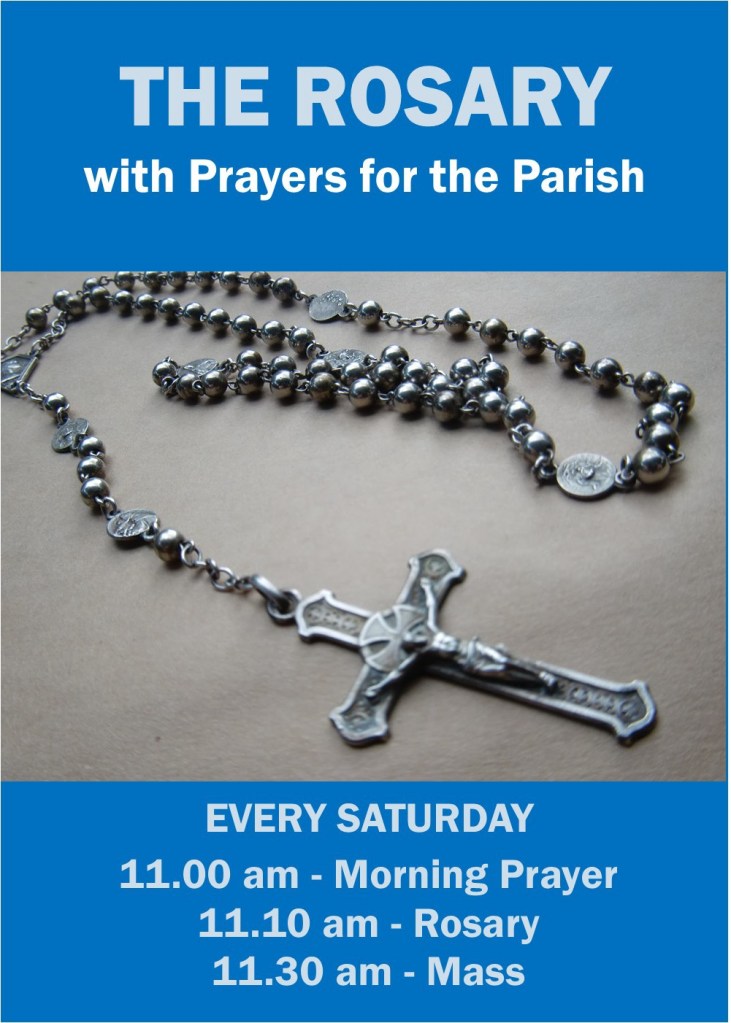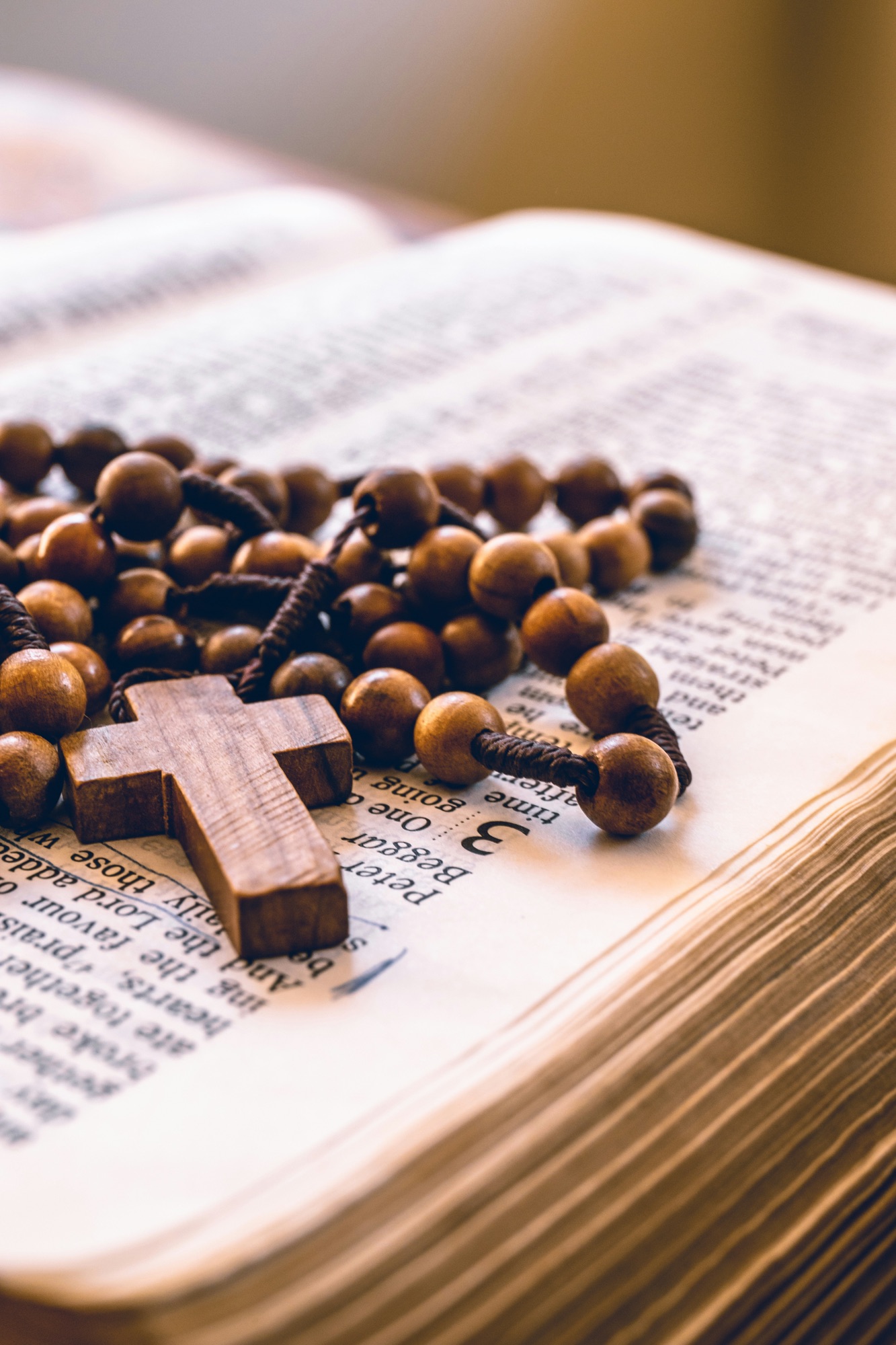We pray the rosary each Saturday at St Mary’s. As we approach Mary’s month of May we explore what it is and how we pray the rosary.
Split beads, snapped cords and chains litter my desk drawer. It’s like a rosary graveyard, the casualties of prayer. I must be too heavy handed when perhaps what is called for is a lighter touch.
So many of us find prayer so difficult that we write it off altogether, or perhaps we just make too big a deal of it, try too hard or think that prayer demands what we just can’t give. And so we fumble around, all fingers and thumbs, snapping cords and splitting beads.
The English word ‘bead’ derives from the old English noun bede which means a prayer. So every bead’s a prayer, a bidding.
The use of beads to bid is a common prayerful practice of many religions. Hinduism and Sikhism, Buddhism and Islam, Shinto, Umbanda, Bahai. All have some way of counting out prayers on beads, making us all fingers and thumbs.
The word “rosary” means a crown or garland of roses. An enclosed garden of flowers, perfect, scented, safe. A place of petals, protected by thorns. We’re so easily split and broken. We bleed in beauty’s grip, a rose between the thorns.

The Rosary’s precursor, a knotted rope held in the hands of the Desert Fathers to count out the ‘Jesus Prayer’ or the Psalms of David, existed in the early centuries of the Church. Today, the tied rope remains a favourite of Eastern Orthodox Christians. So simple, accessible, subtle.
Whilst rosary devotions deepened with St Dominic’s vision of Our Lady in 1214, some form of the prayer was known as distantly as the ninth century, as Christians counted out their Ave Marias, time and time again.
With beads in hand, they prayed the Scriptural greeting of Gabriel, “Hail Mary, full of grace, the Lord is with you,” and Elizabeth’s exclamation in her hill country home, “Blessed are you among women, and blessed is the fruit of your womb.”
By the fifteenth century, Scriptural sentences were an established part of the beads, the biddings, and these became fashioned into fifteen Mysteries of Faith, joyful, sorrowful, glorious, relating the story of Jesus as the Bible tells it so. They were generally unchanged until 2002 when five more Mysteries of Light were introduced by St John Paul II.
The prayers, the beads, the biddings, each rose of the garland become a means of meditating on the life of Jesus. We are drawn deeper to him through the prayer and life of Mary his mother. She is the one who first received him, welcomed him into her life. She is attentive to him, dotes on him, becomes a walking treasure trove of love as she stores up the memories of him in her heart. She meditates on the mysteries as they happen.
She wants us to listen to him, and do whatever he tells us, just as she did in that first Mystery when Gabriel touched and changed her life.
As we thread the beads between our fingers, the repeated prayers still our mind, become as natural as breathing, as we find a momentum of prayer that isn’t heavy handed but relies on the lightness of touch which comes from a mother’s love. Time to breathe. Inhale the scent. Rest in her arms.
The Rosary prayer is like the picking of a lover’s petals. “He loves me, he loves me not” except the litany here is always “He loves me, he loves me, he loves me…” A place of petals protected by thorns, the story of our Salvation comes at a cost, but sorrow’s story turns to light and the glory of what is to come.
Yes, when we pray the rosary, we are all fingers and thumbs but succumb, like Mary, to the love of her son.
We pray the rosary at St Mary’s Church each Saturday morning just after 11am and before the 1130am Mass

The prayers of the rosary
The garland of beads is arranged in five distinct groups so that each of the Mysteries can be prayed in turn.
But before we set off, there are introductory prayers. We make the sign of the cross “In the name of the Father and of the Son and of the Holy Spirit,” and continue with the Apostles Creed.
We recite the Lord’s Prayer, followed by three Hail Marys, and all wrapped up with “Glory be to the Father and of the Son and of the Holy Spirit.” And then, in turn, we pray our way through the petals of love which are the Mysteries of the Rosary. Each mysrery begun with the Lord’s prayer, continuing ten Hail Mary’s and Glory be.
Introductory Prayers
+ In the name of the Father,
and of the Son, and of the Holy Spirit. Amen.
I believe in God,
the Father almighty,
creator of heaven and earth.
I believe in Jesus Christ,
his only Son, our Lord.
He was conceived by the
power of the Holy Spirit
and born of the Virgin Mary.
He suffered under Pontius Pilate,
was crucified, died, and was buried.
He descended to the dead.
On the third day he rose again.
He ascended into heaven
and is seated at the
right hand of the Father.
He will come again
to judge the living and the dead.
I believe in the Holy Spirit,
the holy catholic Church,
the communion of saints, the forgiveness of sins,
the resurrection of the body
and the life everlasting. Amen.
Our Father, who art in heaven, hallowed be thy name; thy kingdom come; thy will be done on earth as it is in heaven. Give us this day our daily bread; and forgive us our trespasses as we forgive those who trespass against us; and lead us not into temptation,
but deliver us from evil. Amen.
Hail Mary, full of grace, the Lord is with thee. Blessed art thou amongst women, and blessed is the fruit of thy womb, Jesus. Holy Mary, Mother of God, pray for us sinners, now and at the hour of our death. Amen.
Glory be to the Father, and to the Son,
and to the Holy Spirit
as it was in the beginning,
is now, and ever shall be,
world without end. Amen.
The Joyful Mysteries
The Annunciation (Luke 1:26-38)
The Visitation (Luke 1:39-56)
The Birth of Christ (Luke 2:1-9)
Presentation of the Lord (Luke 2:22-39)
The Finding in the Temple (Luke 2:41-51)
The Mysteries of Light
The Baptism of Jesus (Mat 3:1-17)
Jesus at the Wedding in Cana (John 2:1-12)
Proclamation of the Kingdom (Mk 1:15)
The Transfiguration (Luke 9:28-36)
Institution of the Eucharist (Mat 26ff)
The Sorrowful Mysteries
The Agony in the Garden (Luke 22:39-46)
The Scourging (Matthew 27:26)
Crowning with Thorns (Mat 27:29-30)
Jesus carries his cross (Luke 23:26-32)
The Crucifixion (Luke 23:33)
The Glorious Mysteries
The Resurrection (Luke 24:1-8)
The Ascension (Luke 24:50-53)
The Descent of the Holy Spirit (Acts 2:1ff)
The Assumption (Revelation 3:21)
The Crowning of Mary (Rev 2:10/12:1)
Concluding Prayers:
Salve Regina
Hail! Holy Queen, Mother of Mercy;
Hail, our life, our sweetness
and our hope;
to thee do we cry, poor banished children of Eve;
to thee do we send up our sighs,
mourning and weeping
in this vale of tears.
Turn then, most gracious advocate,
thine eyes of mercy towards us;
and after this our exile,
show unto us the blessed fruit
of thy womb, Jesus.
O clement! O loving!
O sweet Virgin Mary!
Pray for us, O Holy Mother of God,
that we may be made worthy
of the promises of Christ.
O God, whose only-begotten Son,
by His life, death and resurrection,
has purchased for us the rewards of eternal life;
grant, we beseech thee, that,
meditating upon these mysteries
of the Most Holy Rosary of the Blessed Virgin Mary,
we may imitate what they contain
and obtain what they promise,
through the same Christ our Lord. Amen.

One thought on “Heavy handed prayer”